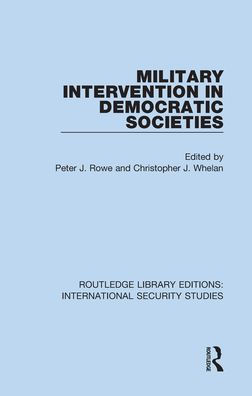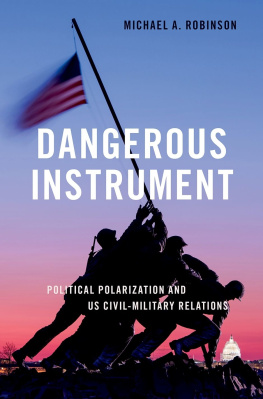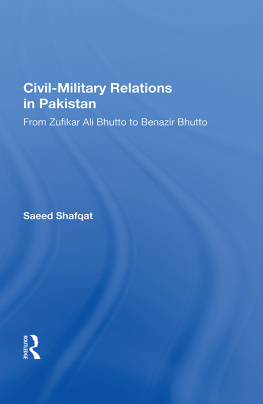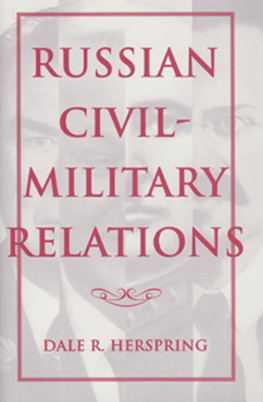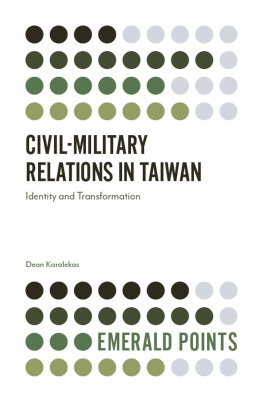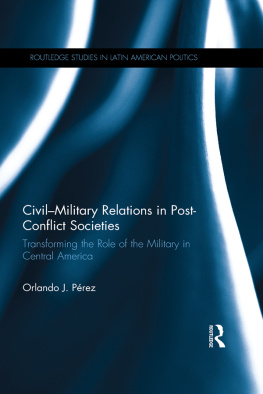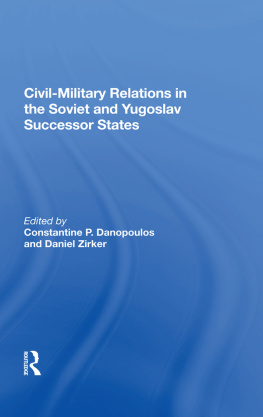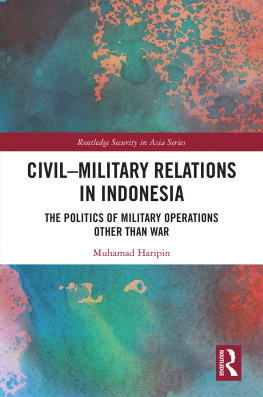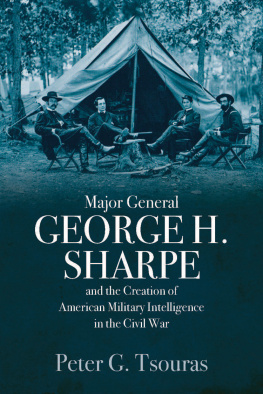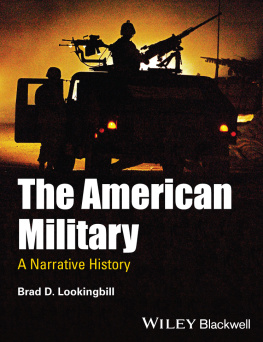COPYRIGHT2004 BY PRINCETON UNIVERSITY PRESS
PUBLISHED BY PRINCETON UNIVERSITY PRESS, 41 WILLIAM STREET,
PRINCETON, NEW JERSEY 08540
IN THE UNITED KINGDOM: PRINCETON UNIVERSITY PRESS,
3 MARKET PLACE, WOODSTOCK, OXFORDSHIRE OX20 1SY
ALL RIGHTS RESERVED
SECOND PRINTING, AND FIRST PAPERBACK PRINTING,
WITH ANEW AFTERWORD, 2005
PAPERBACK ISBN-13: 978-0-691-12427-8
PAPERBACK ISBN-10: 0-691-12427-2
THE LIBRARY OF CONGRESS HAS CATALOGED THE CLOTH EDITION OF THIS BOOK AS FOLLOWS
FEAVER, PETER.
CHOOSING YOUR BATTLES : AMERICAN CIVIL-MILITARY RELATIONS AND
THE USE OF FORCE / PETER D. FEAVER AND CHRISTOPHER GELPI.
P. CM.
INCLUDES BIBLIOGRAPHICAL REFERENCES AND INDEX.
ISBN 0-691-11584-2 (ALK. PAPER)
1. CIVIL-MILITARY RELATIONSUNITED STATES. 2. WAR AND EMERGENCY
POWERSUNITED STATES. I. GELPI, CHRISTOPHER, 1966 II. TITLE.
JK330.F434 2004
322.50973dc21 2003043344
BRITISH LIBRARY CATALOGING-IN-PUBLICATION DATA IS AVAILABLE
THIS BOOK HAS BEEN COMPOSED IN POSTSCRIPT SABON
PRINTED ON ACID-FREE PAPER.
PUP.PRINCETON.EDU
PRINTED IN THE UNITED STATES OF AMERICA
3 5 7 9 10 8 6 4 2
PREFACE
T HIS BOOK began as a series of papers commissioned for the Triangle Institute for Security Studies (TISS) Project on the Gap between the Military and American Society, as explained more comprehensively in Feaver and Kohn (2001b). The TISS project set out to provide systematic data on and analyses of a debate that has been prominent since the mid-1990swhether inherent differences between the military and American society had grown into a troublesome gap that might compromise military effectiveness and civil-military cooperation. Of course there have and always will be differences between military and civilian institutions. But during the stormy tenure of the Clinton administration, many argued that those differences had so sharpened that they were affecting the way national security policy was made and implemented. The TISS project commissioned twenty-one different studies analyzing this issue from a variety of perspectives. Our task was to see whether there was such a gap on matters pertaining to the use of force and, if so, whether it mattered for the actual conduct of American foreign policy.
In this book we show that civil-military differences on the use of force are systematic and, at points, profound, and that these differences shape the behavior of the United States in important ways.
We were attracted to this topic for several reasons. First, it was precisely the kind of policy-relevant question on which good scholarship might make a contribution. There are many policy questions that leave academics out in the cold, and there are probably even more academic topics that have only marginal utility for policymakers. But the nexus of civil-military relations and the use of force brings the academic and policy worlds together. And as we brought this book to completion, the daily headlines on our topicTwo Retired Generals Voice Doubts over Bush's Plan to Attack Iraq, Be Cautious on Iraq, Say War Vets in Congress, and so onconvinced us that our argument could not be more timely.
Second, the project allowed us to blend our separate strengths and interests together in a way that would be better than anything we could do on our own. It is a clich that coauthorship is meant to be coequals generating a product that is considerably superior to what the individuals would have produced on their own. In this case, at least, we are convinced this is true. We have enjoyed a felicitous collaboration matching our various skills and interests. We followed an alphabetical rule in listing authorship, and neither is the lead author in the traditional sense. The basic topic grew directly out of Feaver's prior work on civil-military relations theory, but we approached it in a way that lies more squarely in the tradition of Gelpi's prior work on American conflict behavior. Feaver could not have written this book without Gelpi; Gelpi would not have thought to write the book without Feaver.
Third, the project allowed us to bring together various questions, methods, and approaches that are rarely combined: civil-military topics, survey research, statistical analysis of conflict behavior, and hypotheses generated from the historical case study literature and the op-ed pages of the leading newspapers. We recognize that such a bouillabaisse may not be to everyone's personal taste. But we have tried to blend advanced methods and real world problems in a way that will appeal to the broadest possible audience.
We broke our TISS mandate down into two discrete subtopics: civilian versus military attitudes about the use of force generally (Feaver and Gelpi 1999a) and civilian versus military attitudes about casualties in particular (Feaver and Gelpi 1999b). We quickly discovered that the TISS data were so richand they led us on such fruitful excursionsthat the papers could be expanded and then combined into a separate book. We have separately published earlier versions of some of our findings (Feaver and Gelpi 1999c, 2000; Gelpi and Feaver 2002), and through the public dissemination of the overall TISS study, we have presented portions of our argument in over sixty briefings to a wide spectrum of policy and academic audiences. Our findings have also been discussed and debated in scores of media reports over the past several years. We have benefited from every exchange, especially from the focused critiques and challenges, and this book supersedes the earlier versions of our arguments and represents our definitive statement on the topic.
Our basic argument has not changed substantially since we first released it in 1999, but we have refined it and, we believe, improved it considerably. We hope that people who found the earlier work unpersuasive will find this more so. And those who were already convinced, may nevertheless appreciate the more extensive and nuanced treatment we provide here.
Because of this long genesis and extensive public vetting, we cannot possibly thank all who improved this book with their comments. Richard H. Kohn, who co-directed the overall TISS project and provided extensive (and often trenchantly critical) feedback at every step of the way, deserves singular mention. Equally, Janet Newcity was indispensableshe secured the vital TISS data, her advice was instrumental in the construction of the casualty questions and scenarios, and she provided innumerable comments, suggestions, and critiques, especially regarding the survey analysis, that have greatly improved this work. At the risk of inadvertently omitting someone who aided and abetted our venture, we also want especially to credit Deborah Avant, Andrew Bacevich, Richard Betts, John Brehm, Risa Brooks, Cori Dauber, Hein Goemans, Joseph Grieco, Paul Gronke, John Hillen, Ole Holsti, Bruce Jentleson, Robert Keohane, Eric Larson, Sean Lynn-Jones, Charles Moskos, Dan Reiter, Tom Ricks, Glenn Snyder, and Allan Stam. We also thank the anonymous reviewers for Princeton University Press, the


